
Flocabulary’s instructional approach: Vocabulary word selection process
Flocabulary was built with vocabulary comprehension front of mind, as it is a key indicator for student success. This focus on vocabulary has proven to be essential in education. For instance, Malcolm X’s experience vividly highlights the importance of a rich vocabulary.
While imprisoned, a young Malcolm X resolved to educate himself through books. Immediately, he hit a stumbling block: His limited vocabulary knowledge rendered the texts nearly incomprehensible. To address this, X turned to the dictionary, the breadth of which shocked him. “I’d never realized so many words existed!” he recalled in The Autobiography of Malcolm X. However, he now faced a new problem: He didn’t know which words to learn.
Malcolm X solved this problem by copying out the entire dictionary in longhand, learning each unfamiliar word as he went. “As my word-base broadened, I could for the first time pick up a book and … begin to understand what the book was saying,” he wrote. “Anyone who has read a great deal can imagine the new world that opened.”
Why is vocabulary acquisition important?
Research provides an evidence base for this experience, demonstrating that robust vocabulary knowledge is key to reading comprehension, fluency, and growth, while lack of vocabulary knowledge hinders these areas. To keep up with the increased academic rigor of each grade level, it is recommended that students learn 2,000 to 3,000 new words per year. This monumental task cannot be achieved by incidental learning alone. Effective vocabulary instruction is therefore a necessary component of K-12 curricula.
However, given the sheer number of words in the English language, teachers may find themselves facing the exact question Malcolm X faced: Which words should be selected for intentional learning? This is where Flocabulary comes in.
What is Flocabulary?
Flocabulary’s video-based lessons increase achievement across the curriculum through engaging and educational hip-hop music, along with accompanying lesson activities. Flocabulary core-subject videos feature original hip-hop songs about standards-aligned topics within the subject areas of English language arts (ELA), science, math, social studies, life skills, and current events. Flocabulary Word Up videos focus exclusively on vocabulary learning, featuring original hip-hop songs designed to teach words that frequently come up in standardized tests in each grade.
But whether core subject or Word Up, each Flocabulary video includes a set of carefully selected vocabulary words, along with multiple evidence-based vocabulary-learning activities. This multiplicity is crucial. One-time exposures to new words are insufficient for authentic learning. To develop a deep and lasting understanding of new vocabulary, learners need multiple exposures—and these exposures, along with the instructional approaches, must be varied.
Here’s an example of the type of engaging videos you can find on Flocabulary!
New to Flocabulary? Teachers can sign up for a trial to access our lesson videos and assessment activities. Administrators can get in touch with us to learn more about unlocking the full power of Flocabulary through Flocabulary Plus.
Flocabulary’s approach to vocabulary instruction in each lesson
Combined definitional and contextual approach
Learning words through their definitions (as Malcolm X did) is effective, but research tells us that a combined definitional and contextual approach is more effective than either alone. This two-pronged approach runs through every Flocabulary lesson.
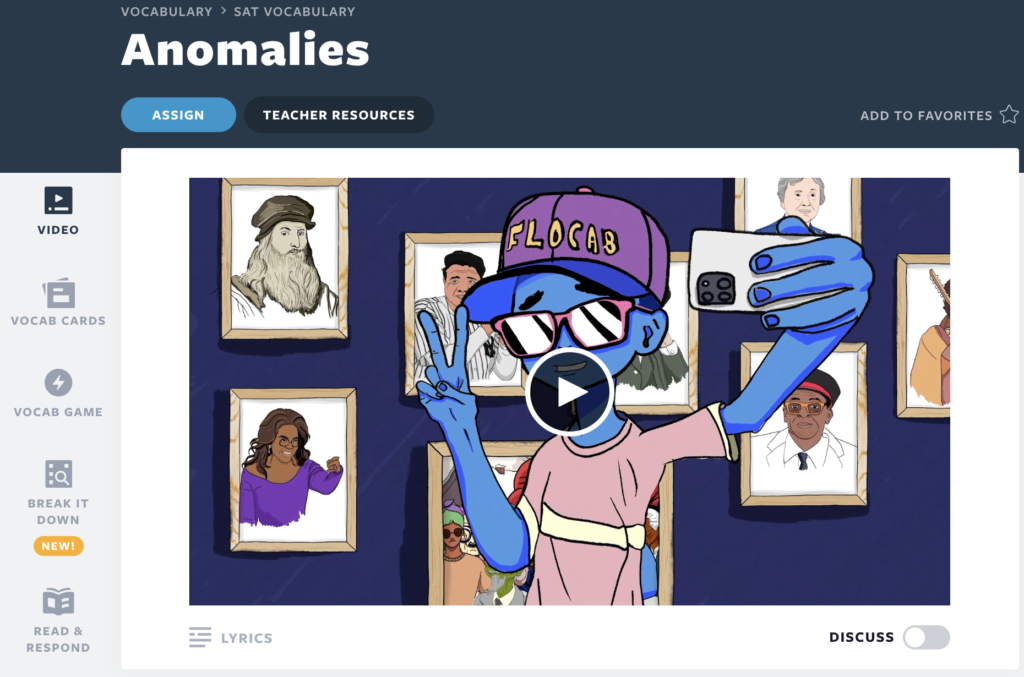
In some cases, word definitions are integrated into the lyrics, as is the case for “obsequious” in the “Anomalies” Word Up:
Amelie could have been obsequious,
Obeying just to please,
But she stood firm in what she believes.
Flocabulary lyrics also provide rich context, enabling students to glean information about word meanings even in the absence of explicit definitions. For example, the social studies “Women’s Rights” video includes this stanza:
We won’t stop till we have a voice.
No discrimination, women have a choice.
We want rights for all people.
Women and men created equal.
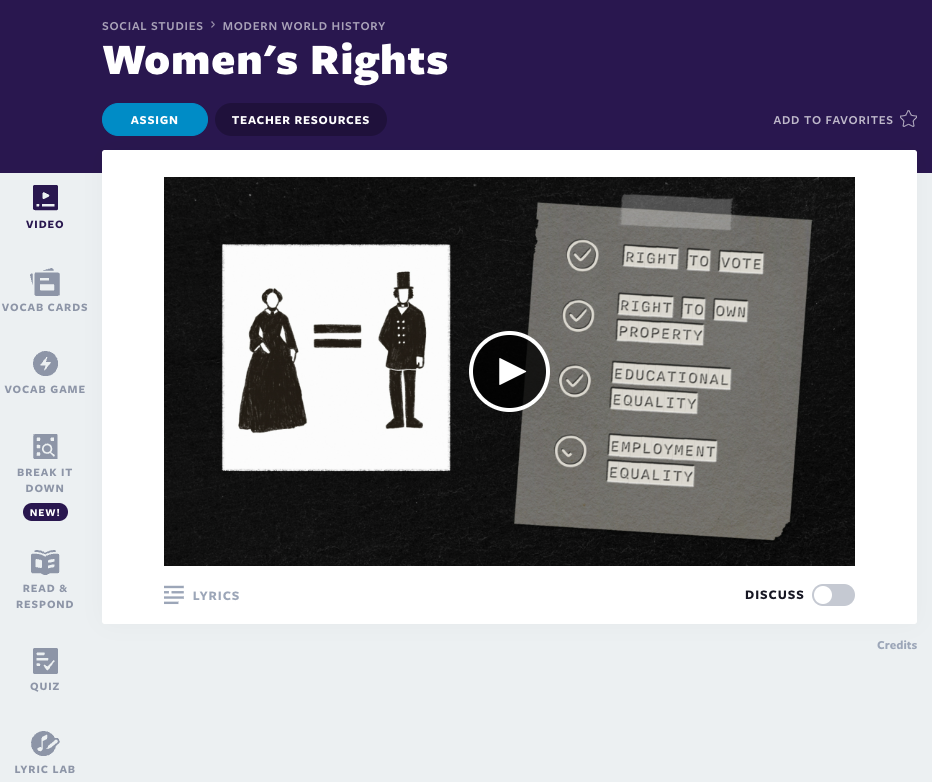
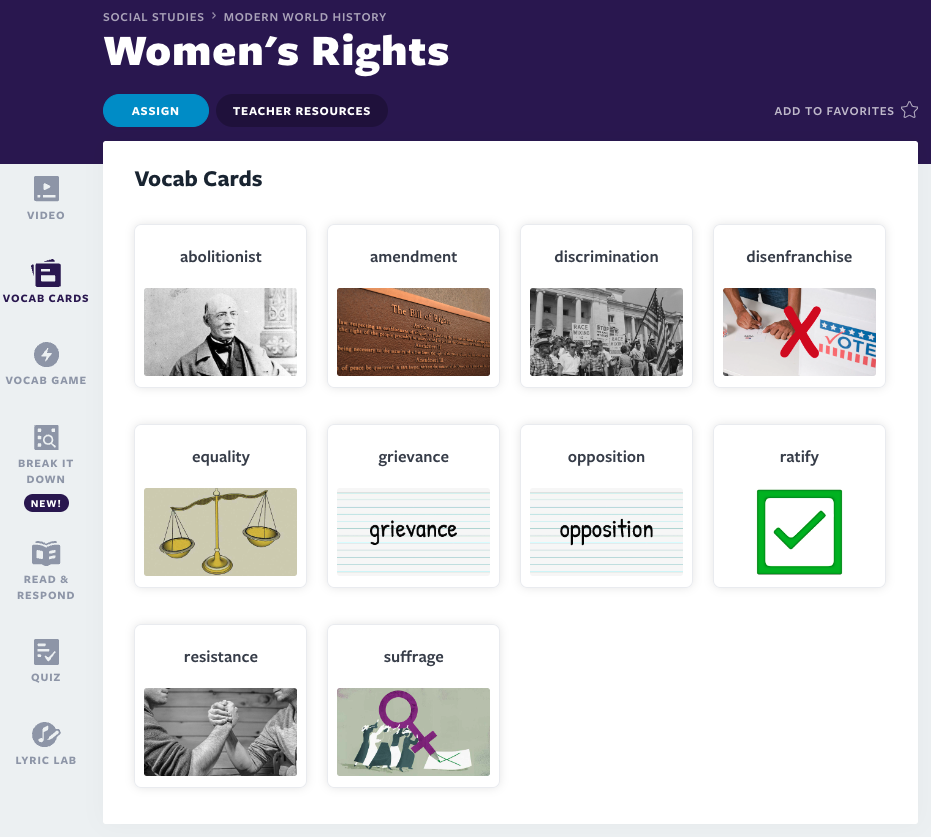
From these context clues, students can infer that “discrimination” has to do with suppression (not having a “voice”), limited opportunities (not having a “choice”), and inequality (not being “equal”). The accompanying footage of public protests provides an additional layer of contextual support, from which students can infer that discrimination is connected to injustice.
Our accompanying lesson activities also make use of both definitional and contextual instruction. For example, each vocabulary card includes the word’s definition, image, a usage example, synonyms, and antonyms. Learners can then test themselves on this lexical information through the vocabulary game. Read and Respond passages offer an additional context exposure for each vocabulary word.
Connections
Understanding how new words fit with known words helps students integrate their vocabulary knowledge. The vocabulary cards and game already tap into this by including synonyms and antonyms. In addition, the Word Up lessons include an activity called “Draw the Relationship,” in which learners find antonym and synonym connections among word groups.
Here’s an example from the I Want Fame Word Up:
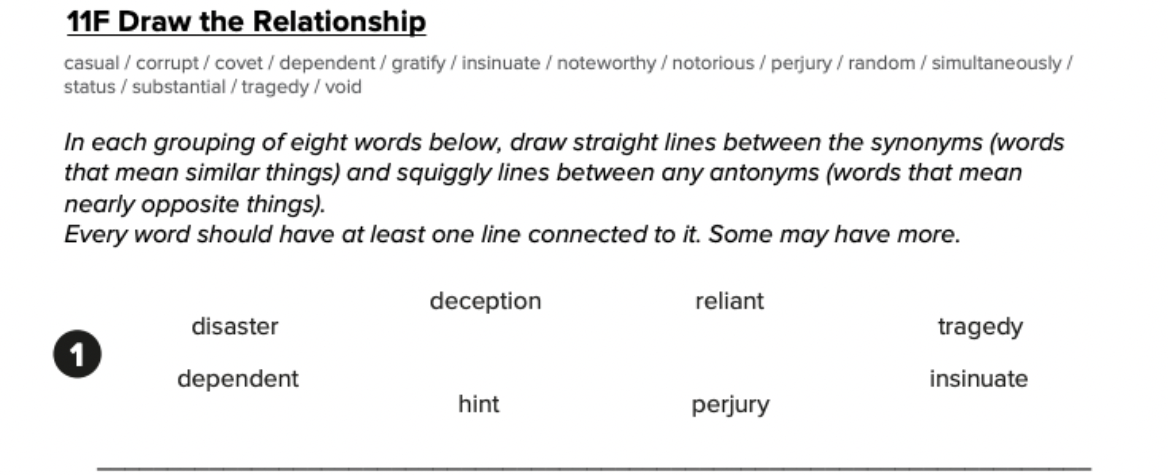
Creativity
Using new words in creative ways helps students to think deeply about them, which aids retention. Each vocabulary card offers a space for learners to use the word in a sentence, as well as a space in which they can draw their representation of the word. In addition, the Word Up lessons include a “Thinking Creatively” section with contextual questions about the target words.
Here’s an example from the Play It Like a Game Word Up:
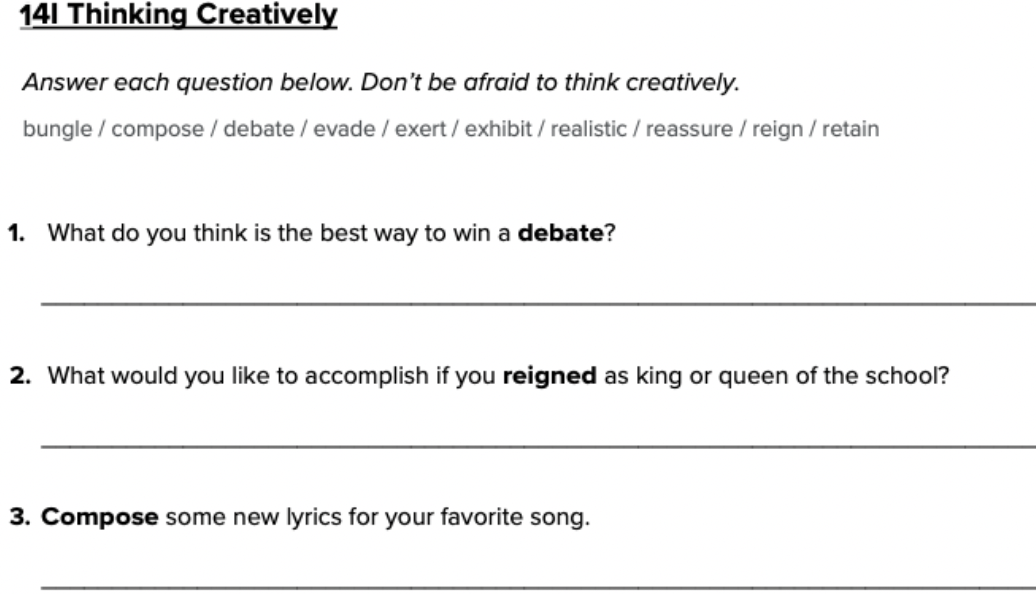
How Flocabulary selects vocabulary words for lessons
Tiers
With such robust vocabulary learning activities, it’s especially important that we select words that will most benefit students. Flocabulary uses Isabel Beck and Margaret McKeown’s three-tiered vocabulary categorization system as a framework for this process.
Tier 1 refers to the most basic words—that is, those gleaned through general conversation. These are typically already known to students, and if not, they are easily explained. Examples include “table,” “book,” “happy,” “green,” and “dog.” Tier 1 words are not included in our vocabulary lists.
Tier 2 refers to high-frequency vocabulary words that are encountered across a variety of domains. These words are more likely than tier 1 words to have multiple meanings. They provide increased nuance, allowing the user to articulate concepts more precisely. Consider, for example, the shades of difference between “sad” (tier 1) and ”serious,” “somber,” and “solemn” (tier 2). Other tier 2 examples are “compensate,” “masterpiece,” “unique,” “fortuitousness,” and “conclusion.” Tier 2 words appear in both informational text and in literature. A robust tier 2 vocabulary is critical to reading comprehension.
Tier 3 words are relatively low-frequency terms that are essential to the comprehension of content-specific domains. These words appear much more frequently in informational passages than in literature. Examples include “calculus,” “bioluminescence,” “neolithic,” “armistice,” and “preposition.”

Core subjects
Core-subject Flocabulary videos include both tier 2 and tier 3 words, though tier 2 words are emphasized.
In selecting tier 2 words for the Flocabulary core-subject videos, we first make sure to choose those that are essential to comprehension of the text—and that could create confusion for students unfamiliar with them.
In Dia de los Muertos / Day of the Dead, for example, the word “altars” was selected for instruction because altars are integral to the observance of Dia de los Muertos. Unfamiliarity with this word could create confusion and gaps for students as they learn about the holiday.
Plus la familia of the dead, they be feeling that it’s necessary
To set up altars at their homes or at the cemeteries.
And on these altars they place pan de muerto, which is bread of the dead—
Sweeter than regular bread.
We also purposefully choose words whose meanings deepen comprehension and engagement by increasing the emotion or building mood. “Dispel” in Harvey Milk is an example.
How could the state promote such discrimination?
Harvey set out to dispel the lies and myths
That led to an initiative like Prop 6.
Utility
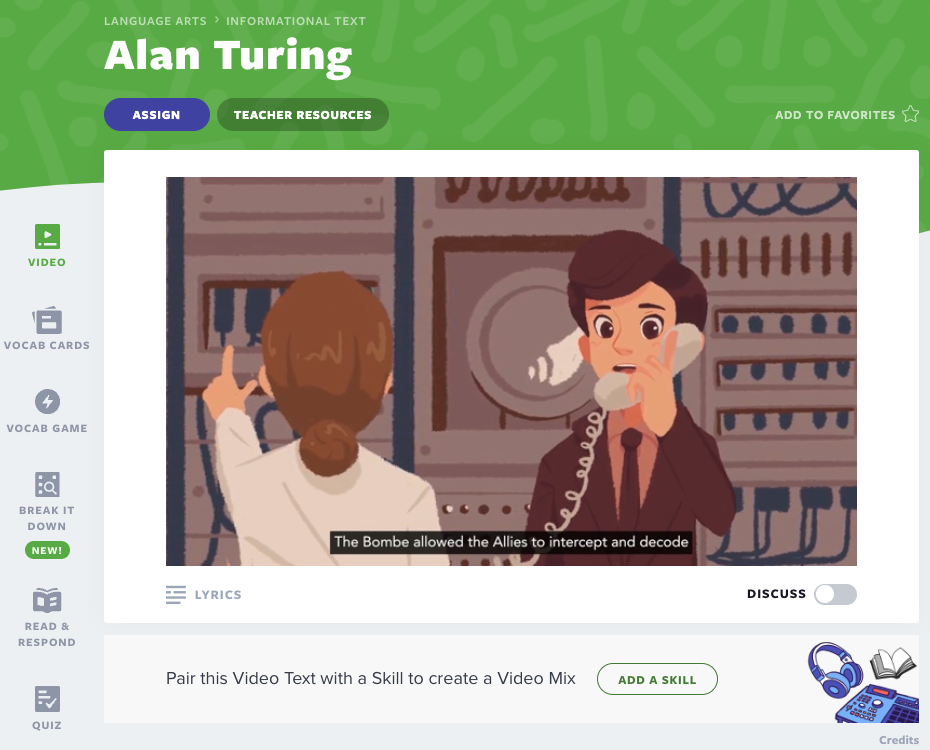
Utility is another consideration; we aim for words that are likely to appear frequently across grade-level texts and which lend themselves to use in multiple academic contexts. For example, our vocabulary list for our Alan Turing video includes “intercept,” a heavily used word across multiple domains, from math to social studies. Students are more likely to encounter “intercept” than the word “indecency,” which is also in the lyrics but which was not selected for instruction.
The Bombe allowed the Allies to intercept and decode
Messages from the German forces and put their plans on hold.
Conceptual familiarity
And finally, we make sure to select words with which students already have conceptual familiarity. While “thrive”—which also appears in the Alan Turing video vocabulary list—may be a new word for some high school students, the concept is one that they can articulate with known words (e.g, they may describe it as “when someone is doing well” or “to succeed and grow”). The new term provides them with a more sophisticated and precise way to refer to these concepts.

Of the three tiers, mastery of tier 2 is most crucial for reading comprehension. However, tier 3 words are essential for understanding domain-specific texts. In choosing tier 3, we focus on comprehension and usability. As with tier 2, we select words that, if left undefined and unstudied, could create a hindrance to comprehension. Also, as with tier 2, we choose words that students are likely to encounter in other texts specific to that domain.
As an example, tier 3 science words are necessary for comprehension of the Marie Curie and Determination video. Therefore, we selected “chemistry,” “radioactivity,” “physicist,” “emission,” “molecular,” and “atom” for the instructional activities.
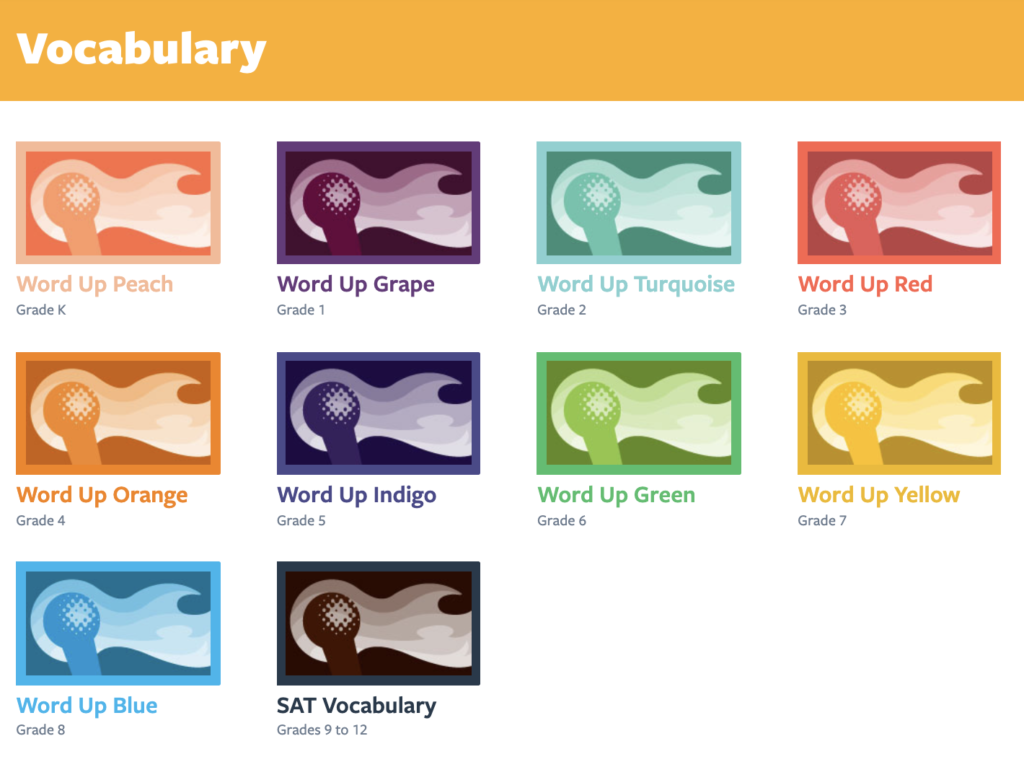
Standardized tests: Word Up
The Word Up lists focus specifically on words that students will encounter on standardized tests. To compile these vocabulary lists, the Flocabulary research team first selected words from grade-appropriate novels and readers, with an emphasis on tier 2 words. The researchers then analyzed the frequency with which these words appeared on state assessments and selected the most commonly occurring words for inclusion in Word Up.
Word Up videos are categorized by grade level, but it’s important to note that the state-test analyses included state tests not only for each level, but also for the next two grade levels. Therefore, the words taught in Level Indigo (grade 5) are words that are found in 5th grade reading material and are also most likely to appear on state tests in 5th, 6th, and 7th grades.
Start using Flocabulary for test prep
At Flocabulary, we believe that teaching is the most important job in the world. We also know that it’s one of the most challenging jobs. We’re committed to providing instructors with the most effective tools possible. Poring over texts in order to select vocabulary words for instruction is a painstaking, time-intensive task—one that can take away from valuable teaching time. But with Flocabulary, teachers don’t have to worry. They can trust that the Flocabulary vocabulary words are chosen with integrity and thoughtfulness, and that they match students’ learning needs. Short of copying out the entire dictionary, we can’t think of a better way for students to learn vocabulary.
New to Flocabulary? Teachers can sign up for a trial to access our lesson videos and assessment activities. Administrators can get in touch with us to learn more about unlocking the full power of Flocabulary through Flocabulary Plus.
